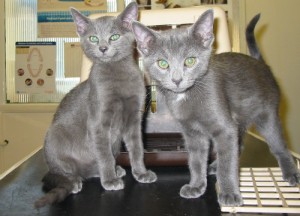Choosing your puppy from a large litter of cute pups can be difficult-
My top ten tips are as follows
- Make sure that the puppy is lively and responds to your stimulation.
- The puppy should have clean bright eyes, clean nose and a clean coat, without excessive scabs or scaling. There may be occasional scabs around the head or neck which can be caused by rough play with littermates which is fine.
- The puppy should be eating solid foods well and generally be more than 6 weeks old.
- Ask to see the mother and if possible the father of the pup. This will give you a good guide of the temperament of the parents which is likely to be passed to the pups. It will also give you a guide to the adult appearance and size of your puppy.
- If a pedigree puppy, ask if there are any screeening schemes that the parents have been through. These may include hip scoring for hip dysplasia (lower score is better, but there is an average score for each breed -generally less than 20), elbow scoring for elbow dysplasia (possible score is 0-3 where 0 is normal and 3 is severly affected), eye testing for genetic eye diseases (categorised as affected or unaffected) . If they have been screened ask to see a copy of the screening results. If you are unsure how to interpret these, make a note of them and speak to your local vet. Further information is available at http://www.bva.co.uk/canine_health_schemes/Canine_Health_Schemes.aspx
- Ask when the puppy was treated for worms. They should generally be treated from the weaning age at around 4 weeks of age, and then every 2 weeks. All pups will be born with some worms and so will require treatment, often with a liquid wormer such as Panacur to start with . It is a good sign of a caring and responsible breeder if they have been regularly worming the pups.
- Try to see where the puppies and mother are actually kept. If they are kept in a dirty barn with many other different breeds of puppies, there is an increased risk of transference of diseases between the pups. The commonly seen diseases include skin problems such as mange, gastrointestinal diseases such as parvovirus, and giardia, and respiratory diseases such as kennel cough. Look for excessive scratching of the puppy, diarrhoea, or coughing which can be a sign of disease.
- Look in the mouth to check the jaw is not overshot or undershot (ie that both upper and lower jaws are the same length and meet normally). This cannot be corrected surgically, but is usually only of cosmetic consequences.
- Feel the belly to check for sign of umbilical hernia , which is a soft fatty swelling under the skin in the middle of the belly, in the region of the umbilical cord. This is caused if the hole that the umbilical cord came through does not close completely after birth, leaving a small hole that fat from inside the belly can pass through. If present this may require surgical correction at a later stage.
- If the puppy is male you may want to check the scrotum for 2 testicles. The testicles normally descend shortly after birth, and are normally visible in the scrotal sac when a puppy is bought at 6-8 weeks of age. If there is only one testicle present, it is possible still that the other testicle will descend a little later, but not guaranteed. If the testicle(s) has not descended by 6 months of age, this is called cryptorchid and your vet will usually recommend that the dog is castrated, to reduce the chances of testicular cancer developing in later life.




